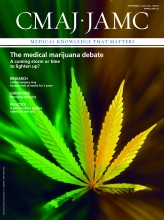Medical marijuana: Time to lighten up?

New regulations guiding the prescribing of marijuana for medical purposes are founded on uncertain evidence. Kahan and Srivastava argue for caution in prescribing medical cannabis. Juurlink argues that it is time to lighten up. See Commentaries, pages 895 and 897
Predictors of stroke after cardiac surgery
Patients who have undergone cardiac surgery are at increased risk of stroke in both the short and the longer term. Using routine databases, Whitlock and colleagues were able to follow more than 100 000 patients for up to 2 years after their cardiac surgery. Age, history of stroke or transient ischemic attack, and peripheral vascular disease were risk factors in the short and long term; new-onset postoperative atrial fibrillation carried only a short-term risk. See Research, page 905
Predicting nonadherence to statins

Information on lifestyle factors readily available to prescribers (body mass index, smoking status, alcohol use and physical activity) may help identify a patient’s risk of nonadherence to newly prescribed statin therapy depending on his or her cardiovascular comorbidity status. A Finnish study of survey and registry data for 9285 people showed that those with cardiovascular comorbidities were at high risk of nonadherence if they engaged in heavy drinking or had a cluster of three to four lifestyle risks. Among those without comorbidities, lifestyle factors were not predictors of increased risk, but overweight, obesity and former smoking were predictors of improved adherence. See Research, page E449
Management of Bell palsy: clinical practice guideline
Although many patients with Bell palsy will experience improvement in their facial nerve function, persistent weakness can have a profound impact on quality of life. This guideline from the Bell Palsy Working Group of the Canadian Society of Otolaryngology – Head and Neck Surgery and the Canadian Neurological Sciences Federation provides recommendations based on the best available evidence for managing this condition. See Guidelines, page 917
Interpretation of TB skin tests
A 52-year-old woman with end-stage renal disease has a tuberculin skin test done before the initiation of hemodialysis. The induration is 11 mm. Should she have had the test done? What do the results mean? Does she require treatment? Redditt and Bunce answer these and other questions about latent tuberculosis infection. See Practice, page 927
Progressive thrombocytopenia

A 67-year-old man developed progressive thrombocytopenia on day 6 after cardiac surgery. A presumptive diagnosis was made based on initial antibody testing and confirmed by a serotonin release assay. What was the diagnosis and what was the most appropriate intervention? See Practice, page 929
Noninvasive prenatal testing
Noninvasive prenatal testing uses a maternal blood sample to screen for specific fetal chromosomal aneuploidies. Although the test has both high sensitivity and specificity, the authors caution that it is not diagnostic and that no irrevocable action should be taken without confirmatory invasive testing. See Practice, page 934
Pyoderma gangrenosum

Red tattoo dye is a known sensitizer and is associated with hypersensitivity reactions. However, in this 39-year-old patient with inflammatory bowel disease, a tattoo also triggered a pathergic response resulting in pyoderma gangrenosum. Litvinov and Sasseville suggest that patients with risk factors should be made aware of this link. See Practice, page 935











